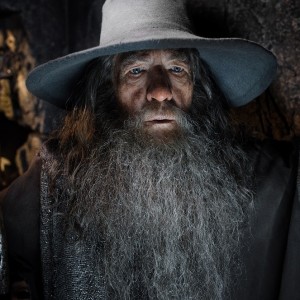‘The Hobbit: The Desolation of Smaug’ Gets the Journey Back on Track
In many ways, Peter Jackson’s middle chapter in The Hobbit trilogy is its predecessor’s doppelganger. There’s the familiar cast of characters: homebody hobbit Bilbo Baggins, wizard extraordinaire Gandalf the Grey, and a company of 13 boisterous dwarves led by the steadfast Thorin Oakenshield. There’s the story: The companions trek inexorably toward the Lonely Mountain’s distant spires, in hopes of reclaiming the great Dwarf Kingdom of Erebor from the dragon Smaug. There’s the wooded and rocky terrain, as picturesque (and treacherous) as ever. A seemingly omnipresent enemy, a vicious orc pack helmed by the particularly unruly Azog the Defiler, lingers unnervingly close by. And the high-frame-rate format tops everything off with a nice, glossy flourish.
And yet The Desolation of Smaug is so much more than its older sibling, An Unexpected Journey. It must’ve eaten its Wheaties, because boy did it grow up fast. While Journey was slow and meandering, full of bulky exposition outlining dwarvish history and with a prolonged shipping-off from Bilbo’s hobbit hole, Desolation isn’t saddled by such weighty goings-on. It dives right into the action and sets our beloved crew in motion at a blistering, urgent pace through the spider-webbed Mirkwood, inhospitable realm of the Wood-elves, and the vast, gilded halls of Erebor, unrelenting until Desolation’s final crescendo to a maddening-yet-delightful cliffhanger ending. A stopover in the canal-lined Lake-Town (yes, it is indeed on the water’s edge) is a mild adrenaline suppressant, and introduces a handful of characters that would be better off swept under the carpet. But then again, even dwarves need time to rest their arms from prolonged axe-swinging.
The pacing isn’t the only thing that’s matured, though. While J.R.R. Tolkien’s The Hobbit, the script’s source material, is very much an adventure tale meant for children’s literary consumption, veteran screenwriting foursome Jackson, Fran Walsh, Philippa Boyens and Guillermo del Toro strip the production of much of the silliness and horseplay that dominated the first installment. A foul essence has entrenched itself in a once-healthy Mirkwood; whispers abound of a resurgent evil; an abandoned fortress, a recurring setting, dominates the skyline like a pock-marked symbol of monolithic decay; even the generally good-natured Bilbo (an excellent Martin Freeman) shows flashes of prickliness as the Ring’s deceiving enchantment begins to take hold. Some dwarvish high jinks remain, to be sure, but it’s clear that a dark cloud shrouds their gregarious disposition — which also has the satisfying effect of adding a layer of depth to Desolation, and ultimately aligning it closely with its Lord of the Rings lineage.
The resurfacing of a few throwback characters like Legolas (Orlando Bloom), ever the acrobatic, silver-haired archer, grounds Desolation further in classic Rings fanboy territory — one particularly awesome set piece in which Gandalf (the always impressive Ian McKellen) dukes it out with a familiar foe will leave Rings junkies with a sizable helping of nostalgia. I know I was as giddy as Bilbo chowing down on second breakfasts.
However, it’s the fresh faces that make Desolation such a compelling sequel. Evangeline Lilly as the hot-tempered elf Tauriel is a lovely addition, and Luke Evans as Bard the Bowman, a skilled sailor and even more adept smuggler, does a fair job with the role. But it’s Benedict Cumberbatch, who motion-captured and voiced the gold-hoarding title character Smaug, that straight up steals the show — or rather, he along with the special effects wizards that brought the low-octave, fire-breathing beast to life. The whole of Desolation is a CGI extravaganza, courtesy of the team at Peter Jackson’s digital visual effects company Weta Digital, led by Oscar-winning senior visual effects supervisor Joe Letteri, but nowhere is it more ostentatiously pronounced than in Smaug’s grand debut. It’s a spectacle of monstrous proportion. And it by no stretch of the imagination disappoints.
I maligned the digital orgy on display in An Unexpected Journey a year ago when it hit the screen, especially Jackson’s superfluous computerization of orc hordes instead of resorting to the award-winning makeup and costume-design combo that proved so effective in Rings. This time around, though, I found the vitriol stuck in my throat. I’m still of the opinion that the director is a bit CGI trigger-happy and that orc and goblin digitization is inferior insofar as overall believability and menace are concerned, but Desolation’s photography wasn’t nearly as distracting or cartoon-y.
There could be a number of reasons for this, one being a rejigged approach to high-frame-rate projection. After the first chapter inspired criticism for a picture many considered to be, strangely enough, too sharp, Jackson sought an improved formula this go-round, attempting to soften the 48-frame-per-second image to achieve a semblance closer to that of traditional film. I viewed Desolation in IMAX 3-D HFR and can’t remember the last time an effects-driven epic looked so good on the big screen. (Side note: Cinema of this scale deserves to be seen in style. Do yourself a favor and buy an IMAX 3-D HFR ticket.) Of course, there’s the more cynical assessment that An Unexpected Journey primed audiences to anticipate the double data projection, and broke them in to be accustomed to the ultra-crispness.
It’s no matter, though, because the 161-minute-long Desolation is one hell of a blockbuster film, both relative to its predecessor and as a stand-alone. Somewhere on the road to the Lonely Mountain, our amiable company found its bearing, and the unexpected journey became a lot more sure-footed.
Rating: 3.5 out of 4 stars
“The Hobbit: The Desolation of Smaug” was released nationwide on December 13, 2013. For more information about the film, please visit http://www.thehobbit.com/.
Video Courtesy of: Warner Bros. Pictures.











